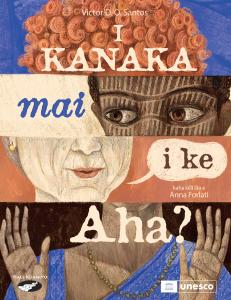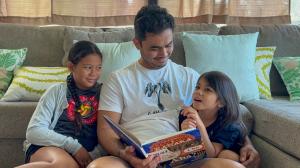VIDEO: Hawaiian language children’s book joins global collection
University of Hawaiʻi at HiloLink to video and sound (details below): https://go.hawaii.edu/Mo8
***VOSOT script below for consideration***
Ka Haka ʻUla O Keʻelikōlani College of Hawaiian Language at the University of Hawaiʻi at Hilo has partnered with the United Nations Educational, Scientific and Cultural Organization (UNESCO) to publish a Hawaiian adaptation of the internationally acclaimed children’s book What Makes Us Human? The book, titled I Kanaka Mai I Ke Aha?, was released on February 21 in recognition of UNESCO’s International Mother Language Day, aligning with the ongoing International Decade of Indigenous Languages (2022–2032) co-led by UNESCO.
“The publication of I Kanaka Mai I Ke Aha? in Hawaiian is another important step in reaffirming our language on the global stage,” said Kaʻiu Kimura, director of UH Hilo’s College of Hawaiian Language. “It not only contributes to our children’s literacy and language development but also reinforces the significance of ʻōlelo Hawaiʻi (Hawaiian language) as a living language, capable of engaging with the world.”
Originally written in Portuguese by Brazilian-American author and linguist Victor D. O. Santos, the book is structured as a riddle, guiding children through the significance of language as a defining element of humanity. Hawaiian is the first Native American language and the first Pacific Island language in which the book has been published.
A playful language
The Hawaiian adaptation was crafted by Kaʻiuokalani Damas, an assistant professor of Hawaiian and Hawaiian studies at UH Hilo, in collaboration with his wife Kauʻilani, a teacher at Nāwahīokalaniʻōpuʻu Hawaiian medium school. The couple is raising their daughters as first-language Hawaiian speakers.
“Hawaiian is a playful language, rich with wit and double meanings,” Damas explained. “This book highlights the critical role of language in human identity while introducing young Hawaiian speakers to the joy of riddles and wordplay.”
Language preservation
The Hawaiian edition joins other Indigenous language versions, such as Mapuzungun of the Mapuche in Chile and Hñähñü of the Otomí in Mexico. UNESCO’s Indigenous Languages Decade highlights the urgency of language preservation. UH Hilo’s Hawaiian Language College leads national revitalization efforts through the National Native American Language Resource Center. Hawaiʻi’s 4,000+ students in Hawaiian medium schools mark a dramatic resurgence from fewer than 50 child speakers just 40 years ago, making it the largest initiative of its kind for a Native American language.
Early literacy is critical in growing the next generation of Hawaiian speakers. Hawaiian medium preschoolers learn to read two years earlier than their English-medium peers through the Hakalama method, a syllable-based system designed for Hawaiian’s unique structure. This approach fosters strong literacy skills and long-term fluency.
The final production of I Kanaka Mai I Ke Aha? was completed through Hale Kuamoʻo Hawaiian Language Center at UH Hilo. Copies are available for pre-order at bit.ly/preorderIKMKA.
Link to video and sound (details below): https://go.hawaii.edu/Mo8
B-ROLL: (1 minute, 34 seconds)
0:00 - 0:14 College of Hawaiian Language welcoming and engaging Indigenous language advocates
0:14 - 0:22 Ojibwe and Yup’ik Immersion classrooms during Hawaiian Language College visits
0:22 - 0:29 Kaʻiuokalani Damas reading the book in his office
0:29 - 0:48 Damas at home reading the book with his daughters Haliʻi and Iunia
0:48 - 1:11 Nāwahīokalaniʻōpuʻu kindergarteners reading in their classroom
1:11 - 1:34 Scenes from the Pūnana Leo preschool featuring their literacy programs and lesson time
Pronunciation guide:
Kaʻiu Kimura (KUH-ee-you)
Kaʻiuokalani Damas (KUH-ee-you OH-kuh LAH-knee Da-muss)
I Kanaka Mai I Ke Aha (EE KUH-nah-ku MYE EE KEH AH-huh)
Ka Haka ʻUla O Keʻelikolani (KUH Ha-kuh OO-lah OH KEH-ay-lee-koh-lah-knee)
SOUND BITES:
Kaʻiu Kimura / Director, Ka Haka ‘Ula o Keʻelikōlani College of Hawaiian Language
(17 seconds)
"We are very fortunate to have experienced some progress and success as it relates to Hawaiian language revitalization, but there’s a lot more work to be done. And so critical to our continued success is our ability to work collectively as Indigenous, endangered languages across the world."
Kaʻiuokalani Damas / Assistant Professor, Ka Haka ‘Ula o Keʻelikōlani College of Hawaiian Language
(12 seconds)
“He papahana kēia mai ka pae kula kamaliʻi a hiki loa i ka puka ʻana he laeʻula paha. A no laila, ʻaʻole pili wale nō kā mākou mau hana i ka honua kulanu i nei.”
(12 seconds) Same SOT as above with English subtitles
“He papahana kēia mai ka pae kula kamaliʻi a hiki loa i ka puka ʻana he laeʻula paha. A no laila, ʻaʻole pili wale nō kā mākou mau hana i ka honua kulanu i nei.”
(Our language revitalization programming includes our preschool through a doctoral program. So, our work isn’t only focused on our endeavors here at the University.)
(8 seconds)
“Nui loa ka makemake o ka Hawai’i i ka nane. Mai ka wā ma mua loa mai, haku ʻia nā moʻolelo piha e pili ana i ka pāʻani ʻana ma ka nane.”
(8 seconds) Same SOT as above with English subtitles
“Nui loa ka makemake o ka Hawai’i i ka nane. Mai ka wā ma mua loa mai, haku ʻia nā moʻolelo piha e pili ana i ka pāʻani ʻana ma ka nane.”
(Hawaiians have long embraced the art of riddles and wordplay. Entire stories were written about characters immersed in the art of riddling)
(14 seconds)
“Ma muli o koʻu hoihoi i ka nane, hoihoi lāua i ka haku nane liʻiliʻi i kekahi manawa. No laila, kēia ʻano puke, ua lilo he pāʻani i waena o mākou. Nui ka leʻaleʻa. Hauʻoli au i ko lāua hoihoi i kekahi puke.”
(14 seconds) Same SOT as above with English subtitles
“Ma muli o koʻu hoihoi i ka nane, hoihoi lāua i ka haku nane liʻiliʻi i kekahi manawa. No laila, kēia ʻano puke, ua lilo he pāʻani i waena o mākou. Nui ka leʻaleʻa. Hauʻoli au i ko lāua hoihoi i kekahi puke.”
(Because of my interest in riddles and wordplay, they have come to enjoy making their own simple ones at times. So, this book has become something fun and playful for us. It makes me happy to see them enjoy it so much!)
***VOSOT script below for consideration***
VOSOT SCRIPT
INTRO
It’s Hawaiian Language Month, and UH Hilo is marking a major milestone. The campus just published an acclaimed children’s book in ʻōlelo Hawaiʻi.
NATS (@:43 little girl speaking Hawaiian: “He puke I loko o ka puke?”)
VO
I Kanaka Mai I Ke Aha? is a Hawaiian adaptation of the global children’s book What Makes Us Human? The adaptation in partnership with UNESCO– was crafted by UH Hilo kumu Kaʻiuokalani Damas (KUH-ee-you OH-kuh LAH-knee Dah-muss) and his wife. UH Hilo is considered a worldwide leader in advancing Hawaiian and Indigenous language and culture revitalization.
SOT
(Kaʻiu Kimura, Director, UH Hilo College of Hawaiian Language)
“We are very fortunate to have experienced some progress and success as it relates to Hawaiian language revitalization, but there’s a lot more work to be done. And so critical to our continued success is our ability to work collectively as Indigenous, endangered languages across the world."
VO
Today, more than 4,000 students attend Hawaiian immersion schools across the state – up from just 50 children four decades ago.



